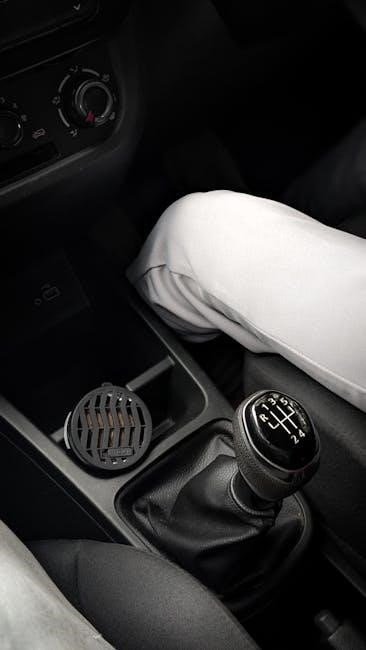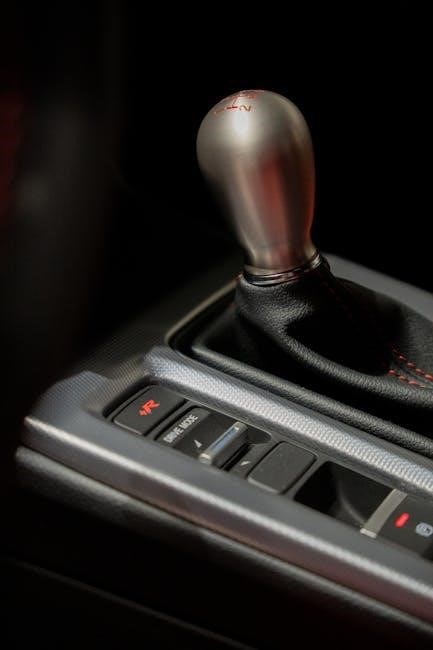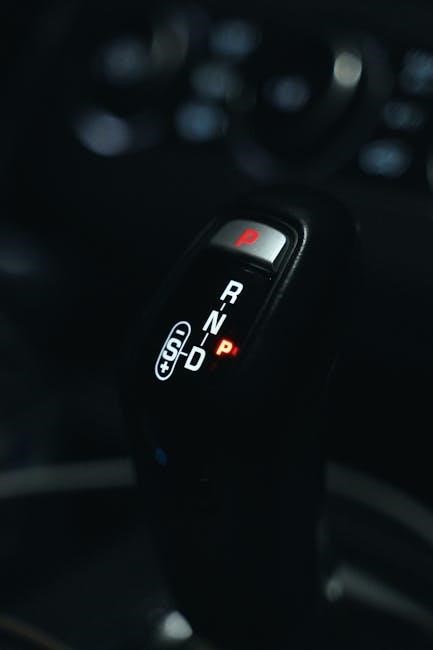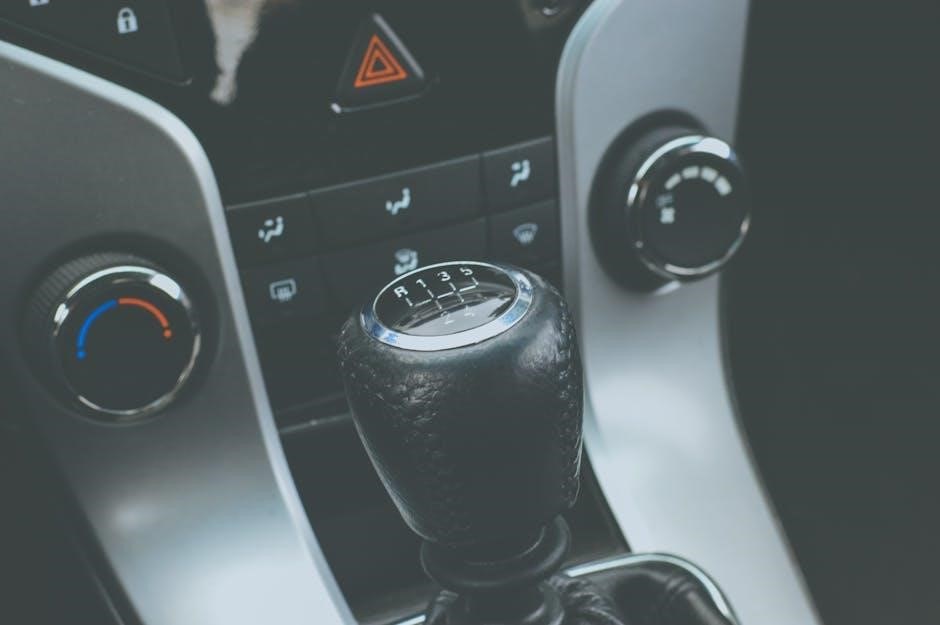The Ford F250 manual transmission offers unmatched control and durability, especially paired with the 7.3L Power Stroke diesel. Available from 1999 to 2020, it featured the ZF 6-speed manual, known for its reliability and smooth shifting. The shift towards automatics led Ford to discontinue manual options in later models.
1.1 Overview of the Ford F250 Manual Transmission
The Ford F250 manual transmission, available from 1999 to 2020, was renowned for its durability and compatibility with powerful engines like the 7.3L Power Stroke diesel. The ZF 6-speed manual transmission stood out for its smooth shifting and reliability, making it a favorite among drivers seeking control and performance. Although Ford eventually phased out manual options in favor of automatics, the F250’s manual gearbox remains popular among enthusiasts and those prioritizing hands-on driving experiences. Its robust design ensured long-term reliability, solidifying its reputation as a trusted heavy-duty workhorse.
1.2 Benefits of a Manual Transmission in the F250
A manual transmission in the Ford F250 offers several advantages, including better fuel economy and lower maintenance costs compared to automatics. Drivers gain more control over gear shifts, enhancing performance in towing and hauling scenarios. The manual gearbox also provides a more engaging driving experience, appealing to enthusiasts. Historically, manual transmissions were preferred for their durability and simplicity, making them a practical choice for heavy-duty tasks. Although Ford discontinued manual options after 2020, the F250’s manual transmission remains a sought-after feature for those prioritizing driver involvement and cost efficiency. Its reputation as a reliable workhorse endures.

History of Manual Transmissions in the Ford F250
The Ford F250 manual transmission was offered from 1999 to 2020, featuring the ZF 6-speed manual as its final iteration. It was phased out due to rising automatic transmission popularity.
2.1 Evolution of Manual Transmissions in F250 Models
The Ford F250 manual transmission evolved significantly over the years, starting with the Borg Warner T-18 and T-170 in the 1980s. These early models were heavy-duty 4-speed and 3-speed transmissions, respectively. By the 1990s, the ZF S5-42 5-speed became standard, offering improved durability and torque capacity. In the 2000s, the ZF 6-speed manual was introduced, providing smoother shifting and better performance. This transmission remained popular until its discontinuation in 2020, marking the end of manual options in the F250 lineup due to declining demand and the rise of automatic transmissions.
2.2 The Rise and Fall of Manual Transmissions in F250
Manual transmissions in the Ford F250 gained popularity for their control and fuel efficiency, especially when paired with the 7.3L Power Stroke diesel. They peaked in the early 2000s, offering drivers a rugged, hands-on experience. However, as automatic transmissions improved in performance and ease of use, demand for manuals declined. By 2020, Ford discontinued manual transmissions in the F250 due to low sales, marking the end of an era. This shift reflected broader industry trends favoring automatics for convenience and modern driving habits.
2.3 The Last Year of Manual Transmission Production
The Ford F250 manual transmission was last produced in 2020, marking the end of an era for enthusiasts of hands-on driving. The final models featured the ZF 6-speed manual transmission, known for its durability and compatibility with the 6.7L Power Stroke diesel engine. Declining demand and the increasing popularity of automatic transmissions led Ford to discontinue manual options. This shift reflected broader industry trends toward convenience and modern driving preferences. The 2020 F250 remains a sought-after choice for those who value the unique experience of a manual gearbox in a heavy-duty truck.

Key Features of the Ford F250 Manual Transmission
The Ford F250 manual transmission, particularly the ZF 6-speed, is known for its reliability, smooth shifting, and compatibility with diesel engines like the 6.7L Power Stroke.
3.1 Specifications of the ZF 6-Speed Manual Transmission
The ZF 6-speed manual transmission, featured in the Ford F250, is a heavy-duty gearbox designed for robust performance. Compatible with diesel engines like the 6.7L Power Stroke, it ensures smooth shifting and durability. With a torque capacity of up to 750 lb-ft, it handles heavy-duty tasks effortlessly. The transmission includes six forward gears and one reverse gear, offering a wide range of ratios for optimal performance. Built with a cast-iron housing and a dual-mass flywheel, it provides long-lasting reliability. This transmission was widely used in F250 models from 1999 to 2007, making it a favorite among drivers seeking control and power.
3.2 Engine Compatibility with Manual Transmissions
The Ford F250 manual transmission is primarily compatible with the 6.7L Power Stroke diesel engine, known for its high torque output. This pairing provides exceptional towing and hauling capabilities. While earlier models offered manual transmissions with gasoline engines, later versions focused on diesel compatibility due to higher demand for heavy-duty applications. The manual transmission was discontinued after 2019, leaving automatic transmissions as the sole option. This shift aligns with industry trends favoring automatics for convenience and performance in modern trucks.
3.3 Unique Components of the F250 Manual Transmission
The Ford F250 manual transmission features a robust ZF 6-speed gearbox, designed for heavy-duty applications. Its gear ratios are optimized for both on-road performance and off-road capability. The transmission includes a heavy-duty clutch system for precise control and durability. A transmission cooler is integrated to maintain optimal operating temperatures, especially under heavy loads. Additionally, the manual transmission is equipped with a shift lever designed for ergonomic comfort and quick gear changes. These components ensure the F250 manual transmission stands out for its reliability and performance in demanding conditions. Production of this transmission ceased after 2019.

How to Choose the Right Manual Transmission for Your F250
Selecting the right manual transmission for your F250 involves considering factors like engine compatibility, year, and intended use. Ensure the transmission matches your truck’s specifications.
4.1 Factors to Consider When Selecting a Manual Transmission
When selecting a manual transmission for your F250, consider compatibility with your engine type, whether gasoline or diesel. Ensure the transmission matches your truck’s year and model. Cab style and bed length also play a role in compatibility. Additionally, check if the transmission is remanufactured or used, as this affects reliability and cost. Warranty options and the reputation of the supplier are crucial for long-term satisfaction. Finally, consider your usage needs—whether for daily driving or heavy-duty tasks—to choose the right transmission for your F250. Consult a specialist for complex setups.

4.2 Compatibility with Engine Types (Gasoline vs. Diesel)
When selecting a manual transmission for your F250, ensure compatibility with your engine type. The ZF 6-speed manual transmission is designed to work seamlessly with the 6.0L Power Stroke diesel engine, offering enhanced torque management. Gasoline engines, such as the 6.2L V8, may require specific transmission configurations. It’s crucial to verify compatibility to maintain optimal performance and avoid mechanical issues. Additionally, the 7.3L V8 engine, known for its power, pairs well with manual transmissions for heavy-duty tasks. Always consult specifications or a specialist to ensure proper engine-transmission pairing for your F250.
4.3 Cab Style and Bed Length Considerations
When choosing a manual transmission for your F250, consider your truck’s cab style and bed length. The ZF 6-speed manual transmission was available across various configurations, including Regular Cab, SuperCab, and Crew Cab models. Bed lengths, such as short or long beds, also influenced transmission compatibility. Ensure the transmission aligns with your truck’s specific setup, as some configurations may require adapters or modifications. Always verify Ford’s specifications for your model year to guarantee proper fitment and functionality. This ensures optimal performance and avoids potential installation issues.

Maintenance and Care Tips for the F250 Manual Transmission
Regular maintenance is crucial for extending the life of your F250 manual transmission. Check transmission fluid levels, inspect for leaks, and follow the recommended service schedule.
5.1 Regular Maintenance Schedule for Manual Transmissions
To ensure optimal performance, regular maintenance of the F250 manual transmission is essential. This includes checking transmission fluid levels monthly and replacing the fluid every 30,000 to 60,000 miles. Inspect the clutch system annually for wear and tear, and replace components like the clutch disc or pressure plate if necessary. Lubricate the shift linkage and universal joints every 15,000 miles to maintain smooth operation. Follow Ford’s recommended service intervals to prevent premature wear and extend the lifespan of your manual transmission. A well-maintained transmission ensures reliability and peak performance for years.
5.2 Importance of Transmission Fluid in Manual Transmissions
Transmission fluid is essential for lubricating gears, reducing friction, and cooling the system in your F250 manual transmission. It prevents overheating and corrosion, ensuring smooth gear engagement and disengagement. Using the wrong type of fluid can lead to premature wear and potential failure. Regular fluid checks are crucial, with recommended changes every 30,000 to 60,000 miles. Always consult your owner’s manual for the correct fluid type and capacity. Proper fluid maintenance extends the transmission’s lifespan and maintains its performance, ensuring reliable operation under heavy-duty conditions.
5.3 Tips for Extending the Life of Your Manual Transmission
To extend the life of your F250 manual transmission, regular maintenance is key. Always use the correct transmission fluid and change it as recommended. Avoid riding the clutch, as this can cause excessive wear. Shift gears smoothly and avoid abrupt movements. Regularly inspect the clutch system for wear and replace it when necessary. Keep the transmission cool by avoiding extreme stress, such as towing heavy loads without proper setup. Monitor for unusual noises or vibrations and address them promptly. Following these tips ensures optimal performance and longevity of your manual transmission.

Troubleshooting Common Issues with the F250 Manual Transmission
Common issues include clutch wear, fluid leaks, and gear misalignment. Diagnose by checking fluid levels, inspecting for leaks, and testing gear engagement. Address problems promptly to prevent further damage.
6.1 Common Problems in F250 Manual Transmissions
Common issues with the F250 manual transmission include clutch wear, transmission fluid leaks, and gear misalignment. Clutch failure often occurs due to excessive wear or improper engagement. Fluid leaks can develop from damaged seals or gaskets, leading to reduced performance. Gear grinding or difficulty shifting may indicate worn synchronizers or bearings. Additionally, the ZF 6-speed manual transmission can experience gear engagement issues, while older 5-speed models may suffer from bearing failure. Regular maintenance and prompt repairs are essential to prevent these problems from escalating.
6.2 Diagnosing Issues with the Clutch System
Diagnosing clutch system issues in the F250 manual transmission involves inspecting for common symptoms like a spongy pedal, difficulty shifting gears, or grinding noises. Check the clutch pedal’s operation, ensuring proper engagement and disengagement. Look for signs of fluid leaks around the slave cylinder and master cylinder, as these can indicate hydraulic system problems. Test the clutch by shifting through gears to identify any resistance or slippage. If issues persist, inspect the clutch disc and pressure plate for wear or misalignment. Regularly checking these components ensures early detection of potential failures, preventing costly repairs down the line.
6.3 Repair Options for a Faulty Manual Transmission
Repairing a faulty F250 manual transmission can be addressed through rebuilding, remanufacturing, or replacing the unit. Rebuilding involves replacing worn or damaged components while keeping the existing housing, often more cost-effective for minor issues. Remanufactured transmissions are thoroughly refurbished to meet factory standards, offering a reliable option with warranties. Replacement is ideal for severe damage, using a new or used unit. Additionally, clutch systems can be repaired or replaced separately if they are the source of the problem. Always consult a transmission specialist for accurate diagnostics and to determine the most suitable repair option for your F250.

Upgrading or Rebuilding the F250 Manual Transmission
Upgrading or rebuilding the F250 manual transmission can enhance performance and durability. Rebuilding focuses on replacing worn components, while remanufacturing offers a factory-standard replacement. Performance upgrades, such as gear ratio changes or clutch improvements, can also be considered. Always consult a transmission specialist for tailored solutions to ensure optimal results.
7.1 When to Consider Upgrading Your Manual Transmission
Consider upgrading your F250 manual transmission if you notice performance issues, such as slipping gears or difficulty shifting. High-mileage trucks, especially those approaching 200,000 miles, often benefit from a rebuild or remanufactured unit. Upgrading is also wise if you’ve increased your truck’s towing capacity or hauling demands, as the stock transmission may struggle under the added stress. Additionally, if your transmission is outdated or lacks modern features, an upgrade can improve reliability and driving experience. Always consult a transmission specialist to determine the best course of action for your specific needs.
7.2 Rebuilding vs. Replacing the Manual Transmission
Deciding between rebuilding and replacing your F250’s manual transmission depends on your needs and budget. Rebuilding your existing transmission can be more cost-effective, especially if the unit is still in good condition. It also allows for customization to better suit your driving habits or performance requirements. However, if your transmission is heavily worn or damaged beyond repair, replacing it with a remanufactured unit is often the better option. Remanufactured transmissions come with warranties and are built to meet or exceed OEM specifications, ensuring reliability and extending the life of your vehicle.
7.3 Performance Enhancements for the Manual Transmission
Enthusiasts seeking to boost their F250’s performance often explore upgrades for the manual transmission. Modifications such as high-performance gear ratios, lightweight flywheels, and upgraded clutch systems can enhance acceleration and towing capacity. Heavy-duty bearings and seals can improve durability under extreme conditions. The ZF 6-speed manual transmission, commonly used in F250 models, can be further optimized with aftermarket components. Remanufactured transmissions, like those from NuTech, offer enhanced torque handling and smoother shifting. For those seeking maximum performance, custom-built transmissions tailored to specific engine setups are available. Always consult experts to ensure compatibility and optimal results.

Resources and Tools for F250 Manual Transmission Owners
Owners can access remanufactured transmissions, repair manuals, and specialist tools for maintenance. Online forums and communities provide valuable insights and support for DIY enthusiasts.
8.1 Recommended Tools for Manual Transmission Maintenance
For maintaining the Ford F250 manual transmission, essential tools include a rebuild kit with bearings, gaskets, and seals, as well as a clutch alignment tool for proper installation. A universal joint puller is necessary for removing the driveshaft, while a dial indicator helps measure bearing wear. Additionally, a transmission fluid pressure test kit ensures fluid levels are accurate. These tools, along with a service manual, are crucial for DIY repairs and regular upkeep, helping to extend the life of the manual transmission. Proper tools ensure precise and efficient maintenance.
8.2 Online Communities and Forums for F250 Owners
Online forums like Ford Truck Enthusiasts and F250 Super Duty Forum provide valuable resources for manual transmission owners. These communities offer troubleshooting guides, DIY repair tutorials, and real-world advice from experienced drivers. Members often share insights on transmission maintenance, clutch replacement, and performance upgrades. Additionally, these platforms connect owners with specialized mechanics and parts suppliers, ensuring access to reliable support. Engaging with these forums can enhance your understanding and help you make informed decisions about your F250 manual transmission.
8.3 Repair Manuals and Guides for DIY Enthusiasts
DIY enthusiasts can benefit from detailed repair manuals specifically designed for the Ford F250 manual transmission. These guides provide step-by-step instructions for rebuilding, troubleshooting, and upgrading the ZF 6-speed manual transmission. Many manuals include wiring diagrams, torque specifications, and tool recommendations. Remanufactured transmissions, such as the S6-750F for 2003-2007 models, often come with comprehensive repair kits. Additionally, online resources like the ZUMBROTA RMTS5-47-6 manual offer insights for 1996-1997 F250/F350 4×4 models. These resources empower owners to tackle repairs confidently, ensuring their manual transmission performs optimally. Always check with trusted retailers for the latest repair guides.

The Ford F250 manual transmission, discontinued after 2020, remains a symbol of durability and driver engagement. Its legacy endures among enthusiasts who value control and tradition.
9.1 Final Thoughts on the F250 Manual Transmission
The Ford F250 manual transmission, discontinued after 2020, remains a favorite among drivers who value control and a direct connection to the truck. Its durability and smooth shifting, particularly with the ZF 6-speed, made it a standout in heavy-duty applications. While automatics dominate modern trucks, the manual transmission’s appeal endures for enthusiasts seeking a more engaging driving experience. Though no longer in production, its legacy lives on as a symbol of a bygone era, cherished by those who appreciate the art of manual shifting in a powerful workhorse like the F250.
9.2 The Future of Manual Transmissions in Heavy-Duty Trucks
The future of manual transmissions in heavy-duty trucks like the F250 appears uncertain, as automakers increasingly favor automatics for their convenience and efficiency. With Ford discontinuing manual options in 2020, the trend suggests a decline in manual transmissions across the industry. However, niche demand from enthusiasts and specific use cases may keep manuals relevant. Emerging technologies, such as hybrid or electric systems, might also influence their revival. For now, manual transmissions remain a cherished relic for those who value a hands-on driving experience in powerful workhorses like the F250.